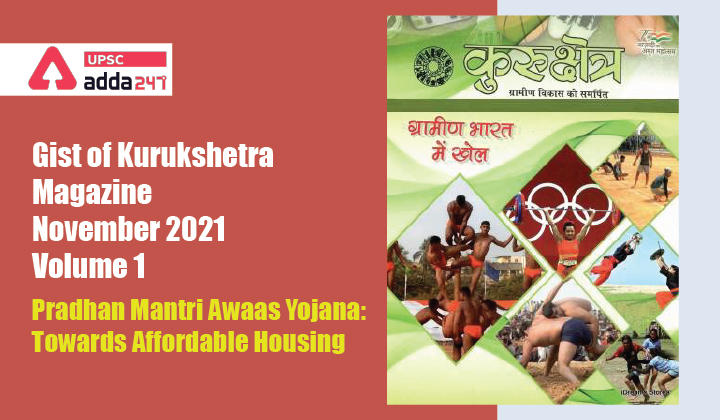Table of Contents
Context
The government has brought in Pradhan Mantri Awaas Yojana-Gramin, which is a revamped version of an earlier scheme(IAY) in terms of design, fund flow mechanism, quality, and other implementation activities.
What is Pradhan Mantri Awaas Yojana(PMAY)?
The Pradhan Mantri Awaas Yojana (PMAY) mission is aimed at addressing the core issue of the housing shortage throughout the country in an organised and planned manner.
Affordable House is a Basic Right
- Various international resolutions International Covenant for Economic, Social and Cultural Change Rights; Vancouver Declaration on Human Resettlements, etc., have recognised adequate housing as a part of the right to an adequate standard of living.
- Recognising the need and significance of easy access to housing for the deprived is of utmost importance and to fulfil the objective of providing shelter to all, India, in June 1996, became a signatory to the Istanbul Declaration on Human Settlement.
- Though, the Indian Constitution does not directly guarantee the ‘Right to Housing’ but has addressed the importance of shelter through the Directive Principle of State Policy (DPSP) and fundamental rights and duties that have a bearing on the right to adequate housing.
Affordable Housing Policy
- Built by private players with government subsidies.
- A large body of work on AH focuses on affordable private housing through a structure of subsidies and financing options, creating optimal supply-side along with favourable revenue measures.
- The government is focusing on creating viable social housing for the at-risk populations such as children, senior citizens, vulnerable populations and the disabled, and private developers and not[1]for-profits obtain a range of subsidies for providing AH.
- Subsidies for AH fall in the planning and land-use regime or take the form of financial incentive mechanisms.
Housing schemes of the Government of India since Independence
- Integrated Subsidised Housing Scheme for Industrial Workers and Economically Weaker – 1952
- Low Income Group Housing Scheme – 1954
- Subsidised Housing Scheme for Plantation Workers – 1956
- Middle Income Group Housing Scheme – 1959
- Rental Housing Scheme for State – 1959
- Slum Clearance and Improvement – 1956
- Village Housing Projects Scheme – 1957
- Land Acquisition and Development Scheme – 1959
- Provision of House Sites of Houseless Workers in Rural Areas – 1971
- Environmental Improvement of Urban Slums – 1972
- Sites and Services Schemes – 1980
- Indira Awas Yojana – 1985
- Night Shelter Scheme for Pavement Dwellers – 1990
- National Slum Development Programme – 1996
- 2 Million Housing Programme – 1998
- Valmiki Ambedkar Malin Basti Awas Yojana – 2001
- Pradhan Mantri Gramodaya Yojana – 2001
- Jawaharlal Nehru National Urban Renewal Mission – 2005
- Pradhan Mantri Adarsh Gram Yojana (2009-10) – 2009
- Rajiv Awas Yojana – 2011
- Pradhan Mantri Awas Yojana- Housing for All – 2015
Genesis of PMAY
- With the aim of addressing gaps in rural housing and providing ‘Housing for All by 2022’, the earlier Indira Awas Yojana was restructured into PMAY-G w.e.f. from April 1, 2016.
- The scheme is aimed at providing a pucca house with basic amenities such as piped drinking water, electricity connection, and Liquefied Petroleum Gas (LPG) connection, by the convergence of different schemes and programmes run by the government, to all homeless and those households living in kutcha and dilapidated houses by 2022.
- The beneficiaries are provided with the unit assistance of Rs. 1.20 lakh for plain areas and Rs. 1.30 lakh for the hilly, difficult, and Integrated Action Plan (lAP) areas.
- Apart from the unit assistance, they are provided with the option of availing institutional finance up to Rs. 70,000 and are entitled to 90-95 days of employment under Mahatma Gandhi National Rural Employment Guarantee Scheme (MGNREGS), Rs. 12,000 for constructing toilets under Swachh Bharat Mission, etc.
- Unlike the minimum size of the house mentioned in lAY to be 20 square metres, the minimum size of the PMAY-G house is increased, and it is estimated to be 25 square metres including a dedicated area for hygienic cooking.
- Instead of selecting a beneficiary from among the BPL households, beneficiaries are selected using housing deprivation parameters in the Socio[1]Economic and Caste Census (SECC), 2011 data which is to be verified by the Gram Sabhas.
- AwaasApp – a mobile application is used to monitor real-time, evidence-based progress of house construction through date and time stamped and geo referenced photographs of the house.
- The programme implementation is to be monitored not only electronically, but also through community participation (Social Audit), Members of Parliament (OISHA Committee), Central and State Government officials, National Level Monitors etc.
How to make AH a possibility?
- Identification of the right clientele.
- Increasing reach through micro mortgage financing mechanisms and self-help groups.
- Flexible paying mechanisms to cater to variable income flows.
- incentivising through policies (extra-floor space index, free sale areas and so on).
- Schemes for slum redevelopment and rehabilitation.
- Ensuring adequate availability of land.
- Streamlining of land records.
- Inclusion of mass housing zones in comprehensive development plans (COPs).
- Encouragement to private participation and partnership.
- Single window clearance for smaller projects on the lines of large township projects.
- Encouraging Public-private partnerships.
- Rethinking floor space index (FSI) limits.
Conclusion
PMAY-G is expected to have a strong forward linkage with other sectors in the economy, the impact on employment and output can be through direct as well as indirect channels to strengthen the rural economy.



 TSPSC Group 1 Question Paper 2024, Downl...
TSPSC Group 1 Question Paper 2024, Downl...
 TSPSC Group 1 Answer key 2024 Out, Downl...
TSPSC Group 1 Answer key 2024 Out, Downl...
 UPSC Prelims 2024 Question Paper, Downlo...
UPSC Prelims 2024 Question Paper, Downlo...
